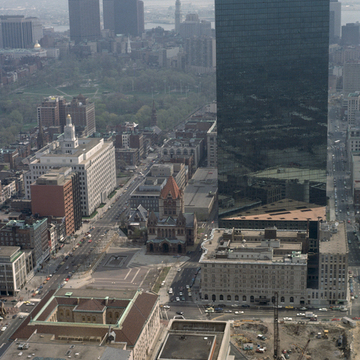Because of its prominence in the life of Boston, it may come as a surprise that Copley Square, a 2.4-acre park named after Boston's native painter John Singleton Copley, was first given a coherent form only in 1968. Surrounding Copley Square are the city's most noteworthy architectural landmarks, namely, Trinity Church, Boston (BB37), the Boston Public Library (BB42), the New Old South Church (BB43), and the John Hancock Tower (BB38), a quartet of diverse architectural styles as distinguished as the institutions. Located on landfill, the site owes its existence to the crossing of two railroad lines. In 1869, it was the focus of singular extravagances from the National Peace Jubilee, which constructed
To remedy its defects, the Copley Square Centennial Committee was formed in 1983 to commission a new scheme. The dense program for the competition inspired the winning team to create a design that simulates an open plaza, if not a New England green, one that is linked physically and visually to its surroundings. Its principal features, such as the Boylston Street fountain, are problematic in form, iconography, and function. At present, the theater ticket office (1994, Graham Gund Architects) at the Dartmouth and Boylston Street corner is an active accessory. The newer and greener plan provides easier pedestrian access (replacing the earlier sunken plaza) and is more tied to the city streets.






